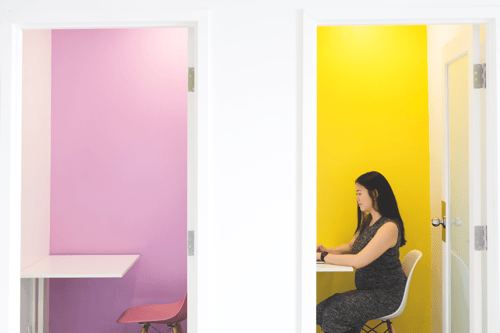Bond
The Future of Work is Here, Is Your Culture Ready For It?
For many organizations, the mass exodus from offices two years ago was a pivotal moment for corporate culture. Deeply rooted in the routines of physical environments, culture failed to translate to the virtual world. Many culprits were at play, from big issues like lack of communication and transparency from leadership, down to those virtual game nights and cocktail hours that just weren’t the same as company baseball games and Beer Fridays. And while employees eventually got used to the new work reality (and came to love it), many still craved water-cooler talk and live whiteboard sessions with colleagues.
Today, we’re at an inflection point where businesses are transitioning to a hybrid or fully remote workplace model and questioning what this means for their culture. Employees want more control over where, when, and how they work. But whatever mix of in-office and remote work you determine is right for your business, you can’t assume your old culture will magically return when you flip the switch to hybrid. Your employees have fundamentally changed.
 Employee concerns about the new work world run deeper than having to come into the office a couple of days a week. Employees have gone through a massive shift in their personal lives, social lives, and work lives, and have reached a point where their tolerance level is much lower than it ever was before. They’re not willing to work in an organization that makes it hard to get their work done, where they're constantly butting heads with co-workers and wading through office politics and red tape. They’re not willing to miss their kids’ soccer games or any number of activities they passed up before because they were too busy with work. And finally, they’re not willing to work with an organization that doesn’t share or support their purpose.
Employee concerns about the new work world run deeper than having to come into the office a couple of days a week. Employees have gone through a massive shift in their personal lives, social lives, and work lives, and have reached a point where their tolerance level is much lower than it ever was before. They’re not willing to work in an organization that makes it hard to get their work done, where they're constantly butting heads with co-workers and wading through office politics and red tape. They’re not willing to miss their kids’ soccer games or any number of activities they passed up before because they were too busy with work. And finally, they’re not willing to work with an organization that doesn’t share or support their purpose.
For employers, the big riddle to solve is how to rebuild, transform, and sustain your culture, wherever (and whenever) your employees choose to work. Given employees’ new needs and the ongoing threat of the Great Resignation, how successful you are will determine your ability to attract and retain talent. When you have new employees coming into a culture that doesn’t meet their needs, it’s difficult for them to be engaged or loyal to you as an employer. And in our remote lives, it’s much easier to find another job and move on.
So, what can you do about it?
Here are six ways to ways to evolve and sustain your culture in a new workplace environment:
1. Lean on your purpose to help design your hybrid culture.
Increasingly, people want to work for organizations with a higher purpose, meaning their employer stands for something bigger than their products and profitability. While it’s trendy now for brands to dream up a purpose statement, many don’t take action beyond that.
Your organization’s purpose should guide all your decisions—big and small. For example, if your purpose is to help people achieve their goals, don’t add red tape and unnecessary steps to an existing process that works well. That’s only going to add to employee frustration and take time away from more important tasks, as well as from their growth and development. Think back to your purpose and ask if the new process (or any other decision) aligns with it.
2. Create inclusive experiences for employees regardless of their location.
Remember that you have very different employees in a hybrid model and the playing field isn’t level. If you’re hiring entry-level employees, for example, they may not be able to afford the luxury of a stand-up desk, ergonomic chair, or even a second monitor. Additionally, a hybrid environment can potentially put remote workers at a disadvantage if your culture prioritizes face-to-face experiences over virtual/digital experiences. Are your at-home employees being treated the same as those in the office? Are you only really hearing in-person employees? The key is to create a unified culture—avoiding two distinct ones—and ensuring employees have equal opportunities whether they’re at home or in the office. This can be done through mapping and assessing your digital employee journey and determining areas of opportunities.
3. Really listen to your employees, and listen constantly.
In a hybrid environment, annual employee surveys alone no longer cut it. It’s important to constantly listen to your employee base and find out what they’re thinking and feeling. Companywide and at a team level, get a monthly pulse check by asking questions like: Do my employees feel supported by their leadership? Do they have tools they need to do their jobs? Do they feel they’re fairly compensated for the work they’re performing? Are they OK?
A voice of the employee mechanism is a must and an ongoing listening strategy to address evolving needs will provide continuous data to design relevant solutions. If you don’t have continuous data to back up your decisions, you will be designing a solution for something that was an issue three months ago. Perhaps the issue has now grown into an even bigger problem, or maybe it’s not even prevalent anymore.
4. Take care of your leaders
According to a recent Gallup survey, people managers reported considerably higher levels of stress and burnout than individual contributors. With the continuing effects of the COVID-19 pandemic, leaders are under a tremendous amount of pressure to deliver on business objectives while also wearing the stress and anxieties of their teams. Leaders have become the connective tissue between organizations and their employees, and evolving to a hybrid culture will require leaders to be agile and learning-oriented. Providing leadership with the right tools, such as coaching, opportunities to share feedback, and a balanced workload, can help them to better navigate these demands while also being able to deliver on objectives. 
5. Create employee personas.
You create personas to better understand your customers—why not your employees? At Bond, we recently did a deep dive into our employee base to create detailed pictures of different groups. Using proprietary tools and analytics work, we were able to segment employees into various categories such as their age, tenure, and their perception of how meaningful their work is. Creating employee personas helps you truly understand who your employees are at a human level. This is absolutely critical: you can’t just think of your people as employees—you have to think about them as the whole human. What do they do outside of work? What are their life goals? How is your organization helping them achieve those goals?
6. Employee experience is everyone’s responsibility, but creating a steering committee helps drive outcomes.
Without question, it is difficult to ensure remote workers have the same experiences and opportunities as in-person employees. Getting this right likely requires a team—let’s call it an Employee Experience Steering Committee.
Everyone should feel responsible and accountable to an organization’s employee experience and culture, and this message should come from the top. However, ensuring at least one person is responsible for leading and implementing any EX and culture initiatives helps to ensure desired outcomes are achieved. A steering committee can be responsible for stepping into the shoes of all the different types of employees to continually understand what they’re feeling, what they’re saying about the organization, and what their perceptions are... and then plan and execute accordingly with the appropriate internal stakeholders.
Transforming culture and employee experience is never easy, and it will take the whole organization to embrace a shift towards the desired state—but if not now, then when? And if not now, will it be too late.